Do you have a question about the Char-Broil 463650413 and is the answer not in the manual?
Indicates an imminently hazardous situation which, if not avoided, will result in death or serious injury.
Indicates a potentially hazardous situation which, if not avoided, could result in death or serious injury.
Indicates a potentially hazardous situation or unsafe practice which, if not avoided, may result in minor or moderate injury.
Recommended initial operation for removing manufacturing oils.
Discourages use of lava rock/charcoal; recommends smoker box for flavor.
Explains grill temperature gauge and limitations of regulator safety feature.
Instructions for pre-heating the grill for optimal performance.
Grilling meat directly over high heat for searing.
Circulating heat without direct contact for slow cooking large cuts.
Best for large roasts/poultry, uses motor and spit for constant turning.
Four basic steps to keep food safe: Clean, Separate, Cook, Chill.
USDA recommended safe minimum internal temperatures for various meats.
Instructions for using wood chips for smoke flavor and wood type recommendations.
Advice on applying sauces to avoid flare-ups and minimize cleaning.
Methods for enhancing flavor using marinades or dry rubs.
Tips on using flat vs. round skewers for even cooking.
Recommendations for using tongs/spatula over forks to retain juices.
Emphasizes prevention and importance of keeping grill clean.
Periodic cleaning after use to remove food particles while grill is warm.
Instructions for cleaning plastic, porcelain, painted, and stainless steel surfaces.
Advice on cleaning cooking surfaces and avoiding loose bristles.
Guidelines for storing the grill, including LP cylinder safety.
Importance of inspecting and cleaning venturi tubes for blockages.
Procedures for safely removing, transporting, and storing the LP cylinder.
Requirements for LP cylinders, including size, construction, and valve features (OPD).
Information on LP gas properties: non-toxic, odorless, flammable.
Guidelines for safe and proper LP cylinder filling by licensed dealers.
Information on exchanging LP cylinders and requirements for safety features.
Procedure for leak testing LP cylinders and connections before use.
Step-by-step guide to connecting the regulator to the LP cylinder.
Detailed steps for leak testing grill components with soapy solution.
Covers safe grill operation, clearance, materials, and usage restrictions.
Specific safety guidelines for apartment dwellers using LP gas grills.
Steps for lighting the grill using the electronic ignition system.
Step-by-step instructions for lighting the grill using a match.
Instructions for lighting the sideburner using electronic ignition or a match.
Covers burner flame checks, turning off the grill, and valve/hose inspection.
Guides for cleaning plastic, porcelain, painted, and stainless steel surfaces.
Advice on cleaning cooking surfaces and avoiding loose bristles.
Details warranty periods for stainless burner, firebox/lid, and other parts.
List of costs and damages not covered by the limited warranty.
Explains warranty disclaimers, limitations, and consumer remedies.
Instructions for installing casters onto the bottom shelf.
Attaching cart side frames to the bottom shelf using machine screws.
Attaching upper door brace and back rail to cart side frames.
Attaching door handle and inserting hinge pins for door assembly.
Lowering and securing the grill head onto the cart.
Attaching side shelf assemblies and explaining folding mechanism.
Placing heat tents over burners by inserting tabs into slots.
Placing cooking grates and installing the AAA battery into the ignitor slot.
Inserting warming rack pivot and leg wires into the grill lid and firebox.
Hanging the grease cup clip and placing the grease cup into the clip.
Placing and securing the LP tank into the bottom shelf.
Possible causes and solutions for gas leaks from hoses, cylinders, or connections.
Causes and solutions for fires involving the control panel or grease buildup.
Troubleshooting issues with burners not lighting using ignitor or match.
Addresses no gas flow, vapor lock, and flame blow-outs.
Troubleshooting electronic ignition problems like no spark, weak spark, or electrode issues.
Detailed steps for electronic ignition problems: no spark, weak spark, arcing.
Troubleshooting match lighting failures and sudden drop in gas flow.
Addressing flare-ups, persistent grease fires, and flashbacks.
Troubleshooting problems with the AUTO-CLEAN™ timer and LED indicators.
Diagnosing issues when no spark or noise is heard from the spark module.
Troubleshooting when spark module makes noise but no spark appears at electrodes.
Diagnosing weak sparks, arcing, or sparks not at electrodes.
Indicates an imminently hazardous situation which, if not avoided, will result in death or serious injury.
Indicates a potentially hazardous situation which, if not avoided, could result in death or serious injury.
Indicates a potentially hazardous situation or unsafe practice which, if not avoided, may result in minor or moderate injury.
Recommended initial operation for removing manufacturing oils.
Discourages use of lava rock/charcoal; recommends smoker box for flavor.
Explains grill temperature gauge and limitations of regulator safety feature.
Instructions for pre-heating the grill for optimal performance.
Grilling meat directly over high heat for searing.
Circulating heat without direct contact for slow cooking large cuts.
Best for large roasts/poultry, uses motor and spit for constant turning.
Four basic steps to keep food safe: Clean, Separate, Cook, Chill.
USDA recommended safe minimum internal temperatures for various meats.
Instructions for using wood chips for smoke flavor and wood type recommendations.
Advice on applying sauces to avoid flare-ups and minimize cleaning.
Methods for enhancing flavor using marinades or dry rubs.
Tips on using flat vs. round skewers for even cooking.
Recommendations for using tongs/spatula over forks to retain juices.
Emphasizes prevention and importance of keeping grill clean.
Periodic cleaning after use to remove food particles while grill is warm.
Instructions for cleaning plastic, porcelain, painted, and stainless steel surfaces.
Advice on cleaning cooking surfaces and avoiding loose bristles.
Guidelines for storing the grill, including LP cylinder safety.
Importance of inspecting and cleaning venturi tubes for blockages.
Procedures for safely removing, transporting, and storing the LP cylinder.
Requirements for LP cylinders, including size, construction, and valve features (OPD).
Information on LP gas properties: non-toxic, odorless, flammable.
Guidelines for safe and proper LP cylinder filling by licensed dealers.
Information on exchanging LP cylinders and requirements for safety features.
Procedure for leak testing LP cylinders and connections before use.
Step-by-step guide to connecting the regulator to the LP cylinder.
Detailed steps for leak testing grill components with soapy solution.
Covers safe grill operation, clearance, materials, and usage restrictions.
Specific safety guidelines for apartment dwellers using LP gas grills.
Steps for lighting the grill using the electronic ignition system.
Step-by-step instructions for lighting the grill using a match.
Instructions for lighting the sideburner using electronic ignition or a match.
Covers burner flame checks, turning off the grill, and valve/hose inspection.
Guides for cleaning plastic, porcelain, painted, and stainless steel surfaces.
Advice on cleaning cooking surfaces and avoiding loose bristles.
Details warranty periods for stainless burner, firebox/lid, and other parts.
List of costs and damages not covered by the limited warranty.
Explains warranty disclaimers, limitations, and consumer remedies.
Instructions for installing casters onto the bottom shelf.
Attaching cart side frames to the bottom shelf using machine screws.
Attaching upper door brace and back rail to cart side frames.
Attaching door handle and inserting hinge pins for door assembly.
Lowering and securing the grill head onto the cart.
Attaching side shelf assemblies and explaining folding mechanism.
Placing heat tents over burners by inserting tabs into slots.
Placing cooking grates and installing the AAA battery into the ignitor slot.
Inserting warming rack pivot and leg wires into the grill lid and firebox.
Hanging the grease cup clip and placing the grease cup into the clip.
Placing and securing the LP tank into the bottom shelf.
Possible causes and solutions for gas leaks from hoses, cylinders, or connections.
Causes and solutions for fires involving the control panel or grease buildup.
Troubleshooting issues with burners not lighting using ignitor or match.
Addresses no gas flow, vapor lock, and flame blow-outs.
Troubleshooting electronic ignition problems like no spark, weak spark, or electrode issues.
Detailed steps for electronic ignition problems: no spark, weak spark, arcing.
Troubleshooting match lighting failures and sudden drop in gas flow.
Addressing flare-ups, persistent grease fires, and flashbacks.
Troubleshooting problems with the AUTO-CLEAN™ timer and LED indicators.
Diagnosing issues when no spark or noise is heard from the spark module.
Troubleshooting when spark module makes noise but no spark appears at electrodes.
Diagnosing weak sparks, arcing, or sparks not at electrodes.
| Model Number | 463650413 |
|---|---|
| Brand | Char-Broil |
| Product Type | Gas Grill |
| Fuel Type | Propane |
| Number of Burners | 4 |
| Cooking Surface Area | 480 sq. in. |
| Primary Cooking Surface Material | Porcelain-Coated Cast Iron |
| Ignition Type | Electronic |
| Tank Size Compatibility | 20 lb |
| Side Shelves | Yes |
| Wheels | Yes |
| Weight | 95 lbs |
| Material | Steel |
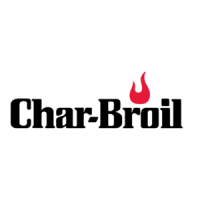
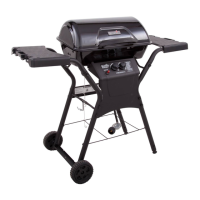
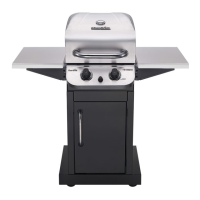
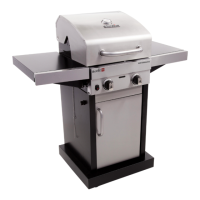
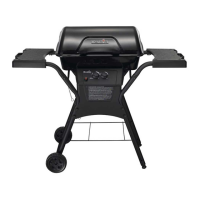
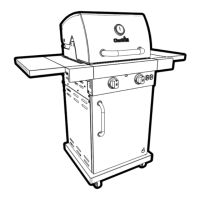

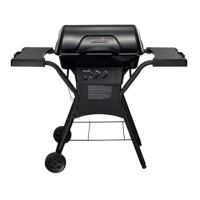
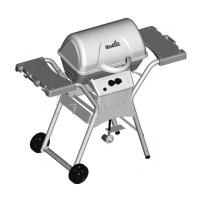
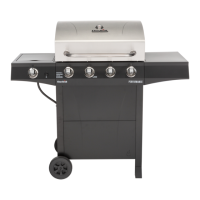
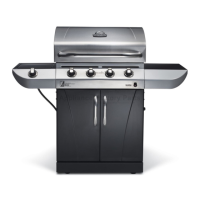
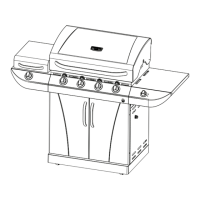
